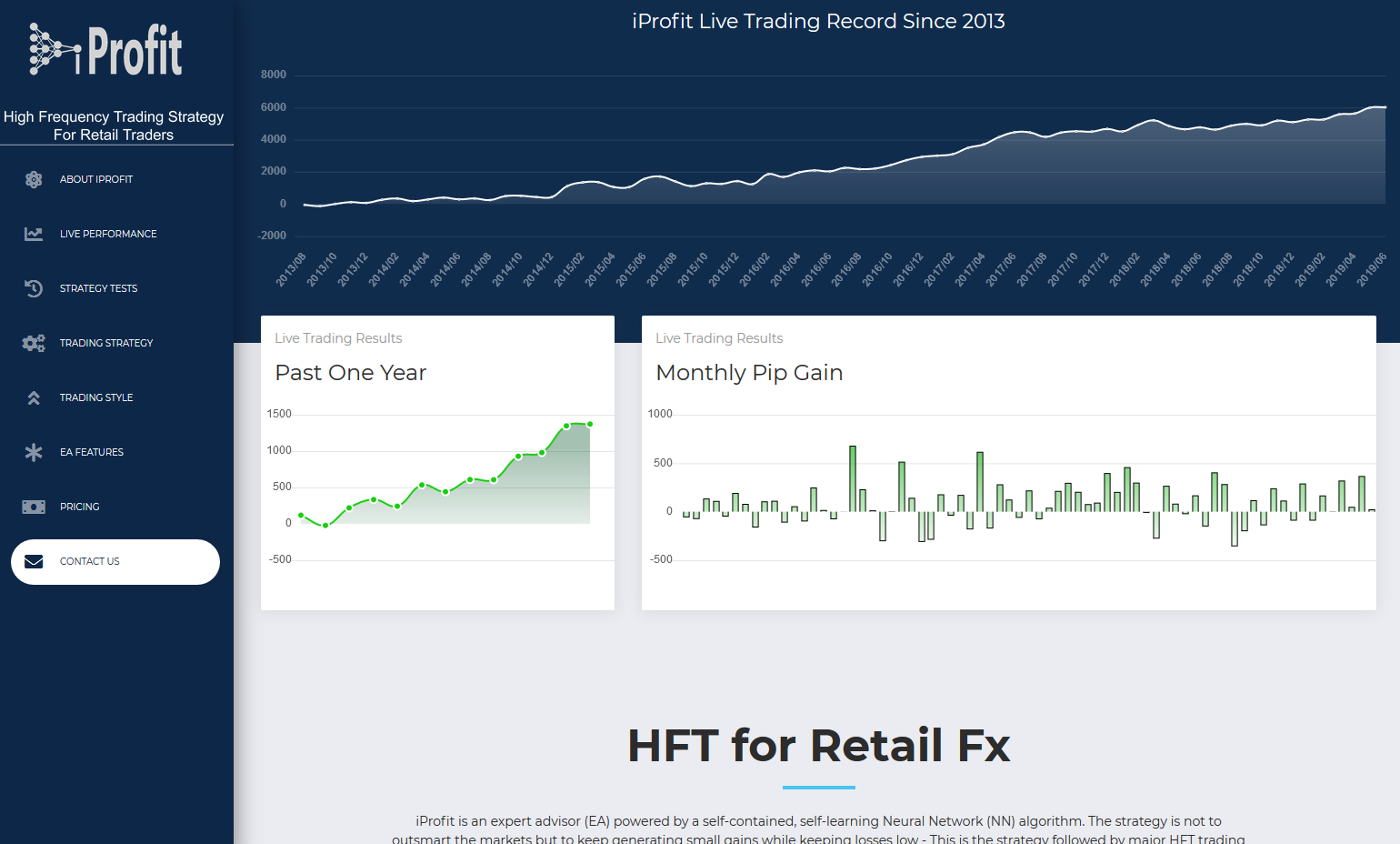Business
iProfit MT4 EA Completes Six Years in Real Trading

The Forex market is the largest in terms of trading volume and offers maximum liquidity. It is easy to enter and exit a position in any of the major currencies within a fraction of a second for a small spread in most market conditions. Financial Institutions and large banks are the major players. They have access to excellent infrastructure, knowledge, real-time information and data to be successful in trading. Retail traders who enter Forex start off with a disadvantage and need to work really hard on every aspect to see profits. Most get lured into Forex trading with unrealistic expectations only to end up losing it all.
ForexInfoBook.com aims to level the playing field for retail Forex traders by providing factual and concise information. The site provides unbiased reviews about Forex trading software, VPS and Brokers.
ForexInfoBook has completed its review of iProfit HFT MT4 EA based on six years of real trading history. It is surprising to see an MT4 EA continue performing well for so many years without any hype. iProfit is not the regular “run-of-the-mill” EA, and promises to be a great tool for serious investors and traders.
History
The strategy has been developed by Phibase Technologies – a software firm specializing in Forex trading research and development. Phibase has been in the field of strategy development since 2011 and their product line includes several automated strategies like Cabex, Raybot, Index and iProfit.
Phibase have had their share of failures with Synergy (2012-2014), Ray Scalper (2012-2015) and Turbit (2014). It must be said that Phibase Team is very professional in their developmental approach and have been around to provide high quality support. It is rare to find professional EA vendors with live trading history to prove that their strategies work in real trading.
What is iProfit Neural Network Trading Strategy?
High Frequency Trading (HFT) strategies are used by large investment banks, hedge funds and institutional investors who have access to powerful computers which can make a large number of transactions at high speeds and low cost. They typically make a very small gain or loss on each trade – the goal is to make a net profit for the day after accounting for all costs involved. Large investment firms may use proprietary algorithms which are usually closely guarded secrets or even some simple strategies like moving average cross overs. Such firms employ many different strategies simultaneously – some of which generate a large number of trades and while other strategies may not trade that frequently, but may aim for larger gains.
It is impractical and unprofitable for retail traders to consider use of such HFT strategies since the spreads, cost of trading and execution slippage/speed are enough to guarantee loss over a period of time.
So what does iProfit HFT for retail trader mean? While HFT strategies function on price data in second or minute time-frames, iProfit EA is based on price from hourly time-frame. Basically the concept appears to be the same – make a large number of trades for small gain-loss and take a net profit at end of trading. iProfit HFT trades about 15 to 20 times per week and tries to make a net profit by end of the week. All trades are closed before market close on Friday. Read the full review of iProfit MT4 EA.
As per the developers of iProfit, the neural network model is a simple model which is designed to just predict the High and Low of the next hour. The EA uses this prediction to make its trade entry and exit. The developers claim that iProfit is powered by a self-contained, self-learning Neural Network (NN) algorithm. The strategy does not try to outsmart the markets but aims to keep generating small gains while keeping losses low – This is indeed the principle of HFT.
It is very rare for a good strategy with proven real trading history to be available for review. The developers of iProfit HFT EA have provided excellent strategy details, tests results and significant amount of information on their website. iProfit HFT EA has been in live trading since August 2013. The trading strategy has survived several different market cycles on a variety of pairs and has made decent gains in the process.
Conclusion
iProfit is most suitable for traders who want to have a safe, proven frequent trading strategy in their portfolio. The EA will deliver small gains on a weekly or monthly basis which quietly add up to grow your account in the background. This is how large investment firms use HFT to make small gains on a segment of their portfolio.
iProfit HFT EA is not for traders looking for “Forex Robots” that promises to “double money every month”. It would also not be suitable for traders with account sizes less than $3000 since the gains will not justify the cost of the EA.
If your Forex trading account size is over $5000 and your broker provides leverage of 1:50 or above – then this is a great way to get started with this retailer version of High Frequency Trading.
Business
The Key Components of a Successful Digital Marketing Strategy

In today’s hyper-connected world, a well-defined digital marketing strategy is essential for any business that wants to grow, build brand trust, and stay competitive. Whether you’re a local retailer, an eCommerce business, or a professional service provider, your online presence plays a major role in shaping how your audience perceives you. For example, industries like legal services are increasingly recognising the benefits of specialised digital marketing for law firms to attract and engage clients in an increasingly digital marketplace.
Below, we explore the key components that make up a successful digital marketing strategy—and how to align them with your business goals.
Clear Objectives and Measurable Goals
Every effective strategy begins with a clear understanding of what success looks like. Your goals might include increasing website traffic, generating leads, improving search engine visibility, or enhancing customer retention. Setting SMART (Specific, Measurable, Achievable, Relevant, and Time-bound) objectives helps ensure that each marketing activity contributes to tangible outcomes.
A Strong Brand Identity
Your digital marketing efforts should reflect a cohesive brand identity that resonates across every channel—your website, social media, email campaigns, and online ads. Consistent visual design, tone of voice, and messaging establish credibility and make your business instantly recognisable.
Search Engine Optimisation (SEO)
SEO remains the backbone of digital visibility. From on-page content optimisation and keyword targeting to technical site health and link-building, SEO ensures your business appears where customers are actively searching. Local SEO, in particular, helps businesses connect with audiences in specific geographic areas—an essential tactic for professionals and service-based businesses.
Engaging Content Marketing
High-quality, relevant content builds authority and nurtures relationships. Blogs, videos, infographics, podcasts, and whitepapers provide opportunities to educate, entertain, and inspire your audience. Great content not only boosts SEO performance but also establishes your brand as a trusted industry leader.
Social Media Engagement
Social platforms allow you to interact directly with your audience, showcase brand personality, and promote your services. The key is to use the right platform for your audience—LinkedIn for B2B engagement, Instagram for visual storytelling, or Facebook for community connection. Regular posting, active engagement, and data analysis are crucial for success.
Paid Advertising (PPC and Social Ads)
Paid campaigns can provide immediate visibility and lead generation, especially when combined with strong targeting and data insights. Tools like Google Ads and Meta Ads Manager allow you to reach specific demographics, remarket to previous visitors, and maximise ROI through ongoing optimisation.
Email Marketing and Automation
Email remains one of the most effective tools for nurturing relationships. Automated workflows can deliver personalised experiences, keeping leads engaged throughout the buyer journey. From newsletters to drip campaigns, consistent and value-driven communication is key.
Data Analytics and Continuous Optimisation
No digital marketing strategy is complete without performance tracking. Tools like Google Analytics, social insights, and CRM data reveal what’s working—and what’s not. Regularly reviewing metrics enables businesses to refine their strategy and continually improve results.
Final Thoughts
A successful digital marketing strategy is more than a checklist—it’s an evolving framework built on research, creativity, and constant learning. When each component works together seamlessly, your business can attract, engage, and convert customers more effectively, while maintaining a powerful and professional online presence.
-

 Tech5 years ago
Tech5 years agoEffuel Reviews (2021) – Effuel ECO OBD2 Saves Fuel, and Reduce Gas Cost? Effuel Customer Reviews
-

 Tech6 years ago
Tech6 years agoBosch Power Tools India Launches ‘Cordless Matlab Bosch’ Campaign to Demonstrate the Power of Cordless
-

 Lifestyle6 years ago
Lifestyle6 years agoCatholic Cases App brings Church’s Moral Teachings to Androids and iPhones
-

 Lifestyle5 years ago
Lifestyle5 years agoEast Side Hype x Billionaire Boys Club. Hottest New Streetwear Releases in Utah.
-

 Tech7 years ago
Tech7 years agoCloud Buyers & Investors to Profit in the Future
-

 Lifestyle5 years ago
Lifestyle5 years agoThe Midas of Cosmetic Dermatology: Dr. Simon Ourian
-

 Health7 years ago
Health7 years agoCBDistillery Review: Is it a scam?
-

 Entertainment6 years ago
Entertainment6 years agoAvengers Endgame now Available on 123Movies for Download & Streaming for Free
